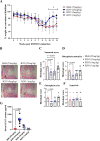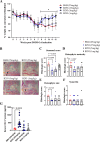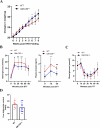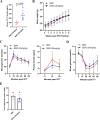Therapeutic blockade of CCL17 in obesity-exacerbated osteoarthritic pain and disease
- PMID: 39820104
- PMCID: PMC11737751
- DOI: 10.1371/journal.pone.0317399
Therapeutic blockade of CCL17 in obesity-exacerbated osteoarthritic pain and disease
Abstract
Objectives: We previously reported that CCL17 gene-deficient mice are protected from developing pain-like behaviour and exhibit less disease in destabilization of medial meniscus (DMM)-induced OA, as well as in high-fat diet (HFD)-exacerbated DMM-induced OA. Here, we explored if therapeutic neutralization of CCL17, using increasing doses of a neutralizing monoclonal antibody (mAb), would lead to a dose-dependent benefit in these two models.
Design: DMM-induced OA was initiated in male mice either fed with a control diet (7% fat) or 8 weeks of a 60% HFD, followed by therapeutic intraperitoneal administration (i.e. when pain is evident) of an anti-CCL17 mAb (B293, 25mg/kg, 5mg/kg or 1mg/kg) or isotype control (BM4; 25mg/kg). Pain-like behaviour and arthritis were assessed by relative static weight distribution and histology, respectively. The effects of B293 (25mg/kg) on HFD-induced metabolic changes, namely oral glucose tolerance test, insulin tolerance test and liver triglyceride levels, were examined.
Results: Therapeutic administration of B293 results in a dramatic amelioration of DMM-induced OA pain-like behaviour and the inhibition of disease progression, compared to BM4 (isotype control) treatment. A similar therapeutic effect was observed in HFD-exacerbated OA pain-like behaviour and disease. B293 treatment did not alter the measured HFD-induced metabolic changes.
Conclusions: Based on the data presented, CCL17 could be a therapeutic target in OA patients with joint injury alone or with obesity.
Copyright: © 2025 Lee et al. This is an open access article distributed under the terms of the Creative Commons Attribution License, which permits unrestricted use, distribution, and reproduction in any medium, provided the original author and source are credited.
Conflict of interest statement
KGL, MB, GB, BAK and EM are employees and shareholders of CSL. The authors have declared that no conflicts of interest exist. This does not alter our adherence to PLOS ONE policies on sharing data and materials.
Figures




Similar articles
-
Targeting GM-CSF for collagenase-induced osteoarthritis pain and disease in mice.Osteoarthritis Cartilage. 2020 Apr;28(4):486-491. doi: 10.1016/j.joca.2020.01.012. Epub 2020 Feb 3. Osteoarthritis Cartilage. 2020. PMID: 32028021
-
CCL17 blockade as a therapy for osteoarthritis pain and disease.Arthritis Res Ther. 2018 Apr 5;20(1):62. doi: 10.1186/s13075-018-1560-9. Arthritis Res Ther. 2018. PMID: 29622035 Free PMC article.
-
The GM-CSF/CCL17 pathway in obesity-associated osteoarthritic pain and disease in mice.Osteoarthritis Cartilage. 2023 Oct;31(10):1327-1341. doi: 10.1016/j.joca.2023.05.008. Epub 2023 May 22. Osteoarthritis Cartilage. 2023. PMID: 37225052
-
High-fat feeding primes the mouse knee joint to develop osteoarthritis and pathologic infrapatellar fat pad changes after surgically induced injury.Osteoarthritis Cartilage. 2020 May;28(5):593-602. doi: 10.1016/j.joca.2020.03.008. Epub 2020 Mar 25. Osteoarthritis Cartilage. 2020. PMID: 32222415
-
Systemic versus local adipokine expression differs in a combined obesity and osteoarthritis mouse model.Sci Rep. 2021 Aug 20;11(1):17001. doi: 10.1038/s41598-021-96545-8. Sci Rep. 2021. PMID: 34417537 Free PMC article.
Cited by
-
Polychlorinated biphenyls induce immunometabolic switch of antiinflammatory macrophages toward an inflammatory phenotype.PNAS Nexus. 2025 Mar 27;4(4):pgaf100. doi: 10.1093/pnasnexus/pgaf100. eCollection 2025 Apr. PNAS Nexus. 2025. PMID: 40191133 Free PMC article.
References
-
- Visser AW, Ioan-Facsinay A, de Mutsert R, Widya RL, Loef M, de Roos A, et al.. Adiposity and hand osteoarthritis: the Netherlands Epidemiology of Obesity study. Arthritis research & therapy. 2014;16(1):R19. Epub 2014/01/23. doi: 10.1186/ar4447 ; PubMed Central PMCID: PMC3978723. - DOI - PMC - PubMed
-
- Chen L, Yao F, Wang T, Li G, Chen P, Bulsara M, et al.. Horizontal fissuring at the osteochondral interface: a novel and unique pathological feature in patients with obesity-related osteoarthritis. Annals of the rheumatic diseases. 2020;79(6):811–8. Epub 2020/04/10. doi: 10.1136/annrheumdis-2020-216942 ; PubMed Central PMCID: PMC7286031. - DOI - PMC - PubMed
MeSH terms
Substances
LinkOut - more resources
Full Text Sources
Medical
Molecular Biology Databases

